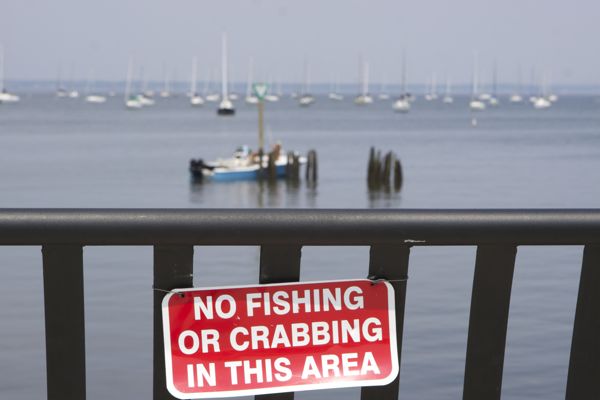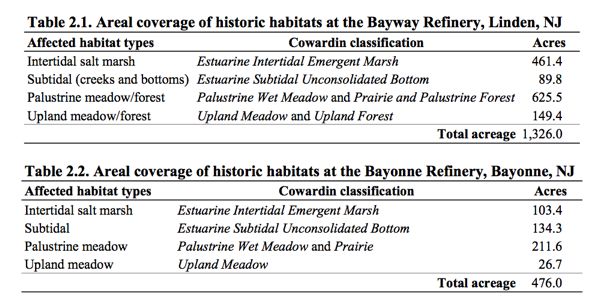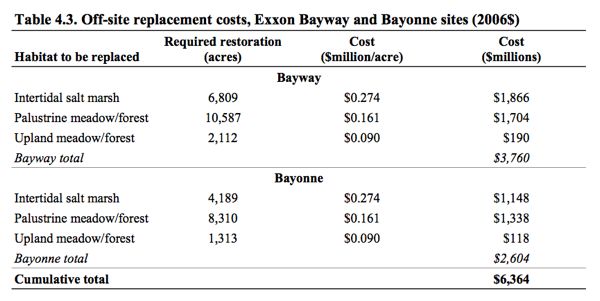Natural Resource Injuries Are Not “Like Pain and Suffering”
NRD is based on science and quantified – NRD is not “inherently subjective”
DEP Consultant Relied on Widely Used & Federally Approved NRD Habitat Equivalence Method
The lack of enforceable NRD regulations is what weakened DEP’s hand in Exxon deal
“There’s this wink and a nod going on where the DEP is saying, ‘We won’t squeeze you too hard if you just come to the table and settle,’” Wolfe said.
It’s been “a quiet little dance for 10 years,” with the state knowing it can’t get more than pennies on the dollar”, Wolfe said. ~~~ NJ Law Journal (4/3/15)
[Update below]
I was hopeful that yesterday’s NJ Law Journal’s story on how DEP’s failure to adopt Natural Resource Damage (NRD) regulations led to the controversial Exxon settlement would pierce the political narrative and get legs.
Instead, it spawned a backlash and is generating a cover story, spun by DEP and lapped up by a reporter who missed the NRD story for years.
As the NJLJ story documented, as we’ve written, DEP lost all 3 NRD cases it litigated, going back over a decade to 2004.
- New Jersey Society of Environmental & Economic Development (SEED) v. Campbell (N.J. Super. Law Div., Mercer County, 2004)
- N.J. Dept. of Envtl. Prot. v. Exxon Mobil Corp., Docket No. MER-L-2933-02 (N.J. Super. Ct. Law Div. Aug. 24, 2007
- New Jersey Department of Environmental Protection, et al. v. Essex Chemical Corporation (Appellate Division, 2012)
As the NJLJ documented, the underlying legal reason DEP lost all 3 NRD cases it litigated was due to a lack of enforceable NRD regulations to define and quantify natural resource injuries and compensation/restoration requirements.
As the NJLJ story exposed, the DEP entered into a legal settlement agreement in the 2004 SEED case that obligated DEP to adopt NRD regulations, a commitment backed up by a letter from the Attorney General’s Office.
But you wouldn’t know any of that by reading today’s Bergen Record story –
Nor would you know that back in 2012, because DEP lost cases, failed to adopt regulations, and was not aggressively recovering NRD compensation, we petitioned the NJ Comptroller to audit the DEP NRD program – which is exactly what Assemblyman McKeon is now seeking to do in a classic after the fact ass covering move.
Jim O’Neill of the Record writes the Christie DEP cover story.
O’Neill uses sources to say that NRD cases are complex (which is true) and that NRD are “like pain and suffering” and “inherently subjective” – which is totally false. Oneill wrote:
Andrew Robins, an environmental lawyer in Newark, said that “natural resource damages in the environmental sphere is akin to the term ‘pain and suffering’ in a personal injury case: It’s very difficult to measure.” […]
“It’s difficult to establish objective criteria to assess damage,” Robins said. “These elements are inherently subjective.”
Robins is clueless.
Quantifying NRD is a science based exercise. One wonders if Mr. Robins or reporter Jim O’Neill even read the DEP consultant’s Report, by Stratus Consulting
Stratus relied on what is known as “Habitat Equivalence Analysis” (HEA) methodology:
The method we used to determine the required off-site replacement is called Habitat Equivalency Analysis (HEA). HEA was developed by the National Oceanic and Atmospheric Administration (NOAA) in the 1990s to determine the amount of restoration needed to offset damages to natural resources from oil spills, hazardous waste releases, and vessel groundings (NOAA, 2000). HEA has been applied at numerous sites around the United States, as well as internationally, and the technical approach for using HEA is described in published articles (e.g., Chapman et al., 1998; Peacock, 1999; NOAA, 2000; Strange et al., 2002, 2004; Allen et al., 2005).
HEA is based on balancing the amount of environmental harm that has occurred at a site with an equivalent amount of environmental restoration, taking into account the duration of the harm and the timing and rate of restoration.1 Using HEA, we calculated the amount of habitat that has been damaged at a site and integrated that damage over time. We then calculated the amount of habitat that needs to be restored to exactly offset the damaged habitat, again integrating the habitat improvements over time.
Stratus found that over 600 organic chemicals had been detected in some 1,600 acres of soil, sediments and wetlands (see table 3.1 for the long list of chemicals). Here are the impacted habitats:
Based on the historic destruction of habitat, Stratus derived on site restoration requirements and off site replacement compensation cost estimates:
The Record story would have us believe that DEP settled the Exxon case because NRD is “complex”, “inherently subjective”, and “like pain and suffering”.
That is just flat out wrong.
Yes, HEA is complex, but it is used under federal Superfund and Oil Spill laws, as discussed by EPA and the Science Advisory Board. Habitat equivalence is approved and used by NOAA.
Habitat equivalence is approved and used by the US Army Corps of Engineers and the US Department of Interior’s Bureau of Land Management.
The DEP’s Office of Natural Resource Restoration even has their own natural resource injury methods documents – one for calculating groundwater injury and one for identifying ecological injury, which defaults to the site remediation program’s “Baseline Ecological Assessment” conducted as part of the cleanup process at contaminated sites.
But none of these HEA or NRD methods have been promulgated as regulations and therefore NJ courts have found that they are legally vulnerable to challenge by polluters.
[***Note: Jeff Tittel just reminded me that when I worked with him at Sierra, around 1997 or so I served on a Whitman Administration DEP NRD Task Force led by Asst. Commissioner Rick Gimello (and coordinated with Asst. Commissioner Jim Hall of Natural Resources). At that time, DEP had NRD formula’s that could have been adopted as rules, but that was nixed by Whitman due to strong opposition by the corporate polluters. More on this historical aspect in future posts.]
That’s why DEP agreed, way back in 2004, to adopt regulations to make the NRD program enforceable.
A March 23, 2003, letter from deputy attorney general Richard Engel to Picco said the DEP “has long planned to promulgate regulations to improve the current Natural Resource Damage program” and “is currently developing its regulatory proposals, and plans to file one or more rule proposals prior to Aug. 1, 2005.”
The “forthcoming rules clearly will afford the NJ SEED plaintiffs an administrative forum, subject to judicial review, in which to present policy and legal arguments presented in or related to the pending litigation,” Engel said in the letter. ~~~~ NJ Law Journal
And DEP’s failure to do so is what led to 3 legal losses and the legal vulnerability that drove the need to settle the Exxon case for less than 3 pennies on the dollar.
[Update: my emphasis on NRD regulations was a key conclusion of a 2006 FDCC Quarterly law review article on DEP’s NRD program – we posted this piece in our 2007 PEER press release:
We conclude that the industry and insurers would be wise to monitor the progress of New Jersey’s NRD initiative, but that there is no clear indication that other jurisdictions will follow New Jersey’s lead. This is in part due to the appointment of a new NJDEP commissioner and NJDEP’s promise to issue new NRD regulations for public comment. The release of these regulations will likely be followed by extensive industry comment and, perhaps, litigation. Thus, New Jersey’s NRD enforcement program is likely to undergo significant changes over the next year, and other jurisdictions will likely wait to see how successful New Jersey is at collecting NRD penalties before devoting resources to beef up their own programs. (page 347 – 348) ~~~ end update]


